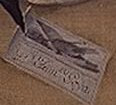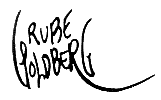
Just as the names of people take various formal and informal styles, artists have been known to sign their works in a great variety of ways. Signing marks have sometimes been the initials of an artist's name (a monogram perhaps), or an impression from a stamp (as in the chop marks of Chinese and Japanese painters, and many ceramic and metal workers), or a symbol (as in James A. M. Whistler's butterfly). Expanding or accompanying a signature might be the title of the work, an inscription (a dedication or explanation perhaps), a date, initials signifying membership in an artist's organization ("RA" for Royal Academy or "AWS" for American Watercolor Society for instance), or the receipt of an honor. Caricaturist Al Hirshfeld (American, 1903-2003) often placed a number after his signature, telling us how many times he'd hidden his daughter Nina's name in that drawing. Students may need to add a mark identifying the class they're in.
Signatures have been placed in many locations on works. Most commonly on drawings and paintings, signatures have been placed just inside the bottom or top edge of the picture. Paintings have been signed in all other areas of pictures, as well as on their backs, stretchers, and frames. When siting a signature deep within a picture, artists have used many sorts of moderating ploys: placing them within cartouches, or on what appears to be a scrap of paper, or in the embroidery on a figure's clothing, etc.
Printmakers have been known to sign within a print's block or plate, or on its support outside of the image.
Typically artists sign works only when they've been finished. Signing a work is frequently the gesture marking a work's completion — the moment, as Picasso put it, that it is ready to be "abandoned."
There are many reasons why an artist might neglect or refuse to sign some works. Often artists have left unsigned works that weren't fully done. Similarly, artists have not signed works when the quality of those works did not meet their standard for signed works. We prize the appearance of the artist's signature on a work for these reasons, but also because it helps to establish the artist's participation in its making. It helps to establish the authenticity and the importance of a work. Consequently the presence of a signature tends to support the market value of a work.
The owners of works of art can feel a justified need to mark their art possessions with their identities, most often because of the need to keep possessions secure. The owners of books wish their libraries to remain intact (picture the ex libris on bookplates), but the later owners of those books can find those bookplates and other marks a mixed blessing. Mark ownership of art possessions with great caution. Because no one lives forever, consider the reversibility / permanence of the label, its size, and position. Owners have most frequently labeled the backs, frames, undersides, and other unobtrusive parts of works. In Chinese and Japanese tradition, both the makers and connoisseurs of paintings have marked the front sides of works with chops.
In the history of forgeries, many artists' signatures have been falsified. This has been done on forged works of course, but also on pieces artists worked on but did not sign.
Thinking of signatures more metaphorically, an artist's style is sometimes considered his/her signature. When an artist is highly exclusively associated with a favored shape, color scheme, brushstroke, medium, content, or some other characteristic, it could be thought of as marking works as his/hers.
Among the problems artists have had with signatures:
In bookbinding, a signature is a sheet after it's been folded. When signatures were folded by hand, the folders initialed their work; hence the word "signature." Also called a signature, but more commonly marking the foot of the first page of each folded sheet or section (a section being a "gathering" or "quire" of signatures within one fold, producing 4, 8, 12, 16, or more pages), are letters or numbers indicating the order in which each section should be bound. In large books, after the alphabet has been used once, traditionally bookbinders continue AA or 2A, etc. Sometimes both letters and numbers are used at the same time. When pages are paginated, such signatures are unnecessary.
Examples of works notable for their artists' signatures:

Attributed to Han Gan (Chinese, active 742-756),
Night-Shining White, T'ang
dynasty, 8th century, ink on
paper, 12 1/8 x 13 3/8 inches (30.8
x 34 cm), Metropolitan Museum of Art, NY. This is one of the
most revered horse paintings in Chinese art. This short scroll displays a formidable provenance
in the form of chops of
its former owners. See equine
art.


Perhaps the most famous monogram of any artist
is that of Albrecht Dürer (German, 1471-1528). He used it
frequently as his signature on his works. The detail on the left
is from the lower-left corner of the engraving Knight, Death, and the Devil, Dürer
placed his monogram and the date within a cartouche.
See Northern
Renaissance.
Francisco José de Goya y Lucientes,
Don Manuel Osorio
 Manrique de Zuñiga (1784-1792),
c. 1786-1788, oil on canvas, 50 x 40 inches (127
x 101.6 cm), Metropolitan Museum of Art, NY. (On the Met's page,
you can enlarge any detail.)
Manrique de Zuñiga (1784-1792),
c. 1786-1788, oil on canvas, 50 x 40 inches (127
x 101.6 cm), Metropolitan Museum of Art, NY. (On the Met's page,
you can enlarge any detail.)  Goya painted his signature on what
looks like his business card
Goya painted his signature on what
looks like his business card --
a bit of trompe l'oeil in
the beak of Don Manuel's pet magpie.
In another work, Goya's signature looked
like this.
James McNeill Whistler (American, 1834-1903),
[detail of] Village Shop, Chelsea, 1883/1884, watercolor
and gouache on
cardboard,
 5
x 8 1/2 inches (12.8 x 21.6 cm), National Gallery of Art, Washington,
DC. This is an image of the butterfly symbol
Whistler painted in lieu of
5
x 8 1/2 inches (12.8 x 21.6 cm), National Gallery of Art, Washington,
DC. This is an image of the butterfly symbol
Whistler painted in lieu of a signature on many of his pictures.

Rube Goldberg
(American, 1883-1970), the cartoonist
signed his work this way. his name is synonymous with "crazy
inventions."

The signature
of Robert Rauschenberg (American, 1925-) at the lower-right
of a painting of 1999. See Pop
Art and combine.
Also see art history, artist, autograph, edition, finish, folio, limited edition, logo, octavo, paraph, provenance, pseudonym, quarto, sign, and trademark.
https://inform.quest/_art